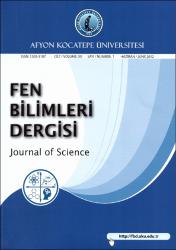Afyonkarahisar Organize Sanayi Bölgesi mermer artıkları depolama sahasının yer altı suyuna olan etkisinin incelenmesi
Özet
Afyonkarahisar bölgesinde 400 civarında mermer işleme tesisinde yılda yaklaşık 300.000 ton sulu,
200.000 ton katı mermer artığı oluşmaktadır. Bu artıklar 3 bölgede (İscehisar, Susuz Boğazı ve Organize
Sanayi) bulunan atık depolama sahalarında toplanmaktadır. Afyonkarahisar Organize Sanayi Bölgesinde
bulunan 40 adet mermer işleme tesisinden yıllık 60.000 ton katı, 120.000 ton sulu mermer artığı
oluşmaktadır. Bu artıkların 45.500 ton katı ve 97.500 ton sulu artık Afyon Çimento T.A.Ş. tarafından
çimento üretiminde kullanılmıştır. Bu makalede Organize Sanayi Bölgesinde bulunan mermer
artıklarının yer altı suyuna etkisini incelemek amacıyla civarda bulunan su kuyularından örnekler
alınarak kimyasal analiz yapılmıştır. Yeraltı suyunda mermer artıklarından kaynaklanabilecek su
kirliliğinin tipik göstergesi Ca ve Mg iyonlarının konsantrasyonundaki değişimdir. 2000-2007 yılları
arasında Ca Mg iyonlarındaki artış oranı sırasıyla; %1.22, %2.94, %0.72 ve %0.17 olarak belirlenmiştir. Ca
ve Mg iyonlarında son 7 yıl içerisinde kayda değer bir artış gözlenmemiştir. Bu verilere göre mermer
artık depolama sahasının yeraltı suyuna herhangi bir olumsuz etkisinin olmadığı söylenebilir. Abstract Almost 400 marble cutting and processing plant in the region of Afyonkarahisar create 300.000 tones
slurry and 200.000 tones solid marble waste. These wastes gather around in the waste storage fields of
3 areas (İscehisar, Susuz Boğazı and Organized Industrial Zone) in Afyonkarahisar. 40 marble cutting and
processing plant which are located in the Organized Industrial Zone of Afyonkarahisar create 60.000
tones solid and 120.000 slurry marble wastes. 45.500 solid and 97.500 slurry wastes of them are used in
cement production by Afyon Cement Factory. In this paper, in order to investigate the effect of
underground water to marble wastes around the Organized Industrial Zone some samples were taken
from water wells around that area and chemical analysis is performed to them. The reason of the
contaminant in the underground water is marbles wastes which highly contain Ca and Mg ions. The rate
of increase in Ca and Mg ions between 2000 and 2007 is determined respectively %1.22, %2.94, %0.72
and %0.17. In the last 7 years, there has not been seen such an important increase in Ca and Mg ions.
According to these data, it can be said that underground water is not adversely affected by the marble
waste storage field.
Kaynak
Afyon Kocatepe Üniversitesi, Fen Bilimleri DergisiCilt
12Sayı
1Bağlantı
https://dergipark.org.tr/tr/pub/akufemubid/issue/1593/19811https://hdl.handle.net/11630/7720
Koleksiyonlar
- Cilt 12 : Sayı 1 [18]
- Makaleler [69]



















